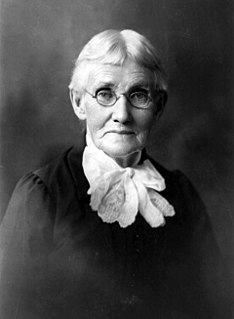
Mary Ann Bickerdyke, also known as Mother Bickerdyke, was a hospital administrator for Union soldiers during the American Civil War and a lifelong advocate for veterans. She was responsible for establishing 300 field hospitals during the war and served as a lawyer assisting veterans and their families with obtaining pensions after the war.

Mary Livermore, born Mary Ashton Rice, was an American journalist, abolitionist, and advocate of women's rights.
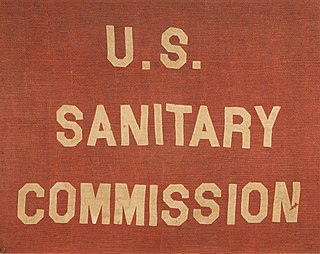
The United States Sanitary Commission (USSC) was a private relief agency created by federal legislation on June 18, 1861, to support sick and wounded soldiers of the United States Army during the American Civil War. It operated across the North, raised an estimated $25 million in Civil War era revenue and in-kind contributions to support the cause, and enlisted thousands of volunteers. The president was Henry Whitney Bellows, and Frederick Law Olmsted acted as executive secretary. It was modeled on the British Sanitary Commission, set up during the Crimean War (1853-1856), and from the British parliamentary report published after the Indian Rebellion of 1857.

USS Red Rover (1861) was a 650-ton Confederate States of America steamer that the United States Navy captured. After refitting the vessel, the Union used it as a hospital ship during the American Civil War.
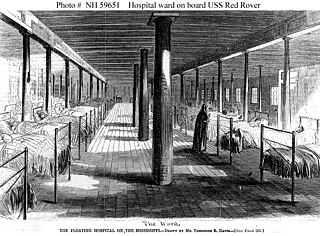
Frederick Law Olmsted, the executive director of the United States Sanitary Commission, set up a system of hospital ships for wounded and sick soldiers during the American Civil War. The USSC was a private agency that cooperated closely with the U.S. Army.
During the American Civil War, Indianapolis, the state capital of Indiana, was a major base of supplies for the Union. Governor Oliver P. Morton, a major supporter of President Abraham Lincoln, quickly made Indianapolis a gathering place to organize and train troops for the Union army. The city became a major railroad hub for troop transport to Confederate lands, and therefore had military importance. Twenty-four military camps were established in the vicinity of Indianapolis. Camp Morton, the initial mustering ground to organize and train the state's Union volunteers in 1861, was designated as a major prisoner-of-war camp for captured Confederate soldiers in 1862. In addition to military camps, a state-owned arsenal was established in the city in 1861, and a federal arsenal in 1862. A Soldiers' Home and a Ladies' Home were established in Indianapolis to house and feed Union soldiers and their families as they passed through the city. Indianapolis residents also supported the Union cause by providing soldiers with food, clothing, equipment, and supplies, despite rising prices and wartime hardships, such as food and clothing shortages. Local doctors aided the sick, some area women provided nursing care, and Indianapolis City Hospital tended to wounded soldiers. Indianapolis sent an estimated 4,000 men into military service; an estimated 700 died during the war. Indianapolis's Crown Hill National Cemetery was established as one of two national military cemeteries established in Indiana in 1866.
The word "nurse" originally came from the Latin word "nutrire", meaning to suckle, referring to a wet-nurse; only in the late 16th century did it attain its modern meaning of a person who cares for the infirm.
During the American Civil War, sexual behavior and gender roles and attitudes were affected by the conflict, especially by the absence of menfolk at home and the emergence of new roles for women such as nursing. The advent of photography and easier media distribution, for example, allowed for greater access to sexual material for the common soldier.

The state of medical knowledge at the time of the Civil War was extremely primitive. Doctors did not understand infection, and did little to prevent it. It was a time before antiseptics, and a time when there was no attempt to maintain sterility during surgery. No antibiotics were available, and minor wounds could easily become infected, and hence fatal. While the typical soldier was at very high risk of being shot and killed in combat, he faced an even greater risk of dying from disease.
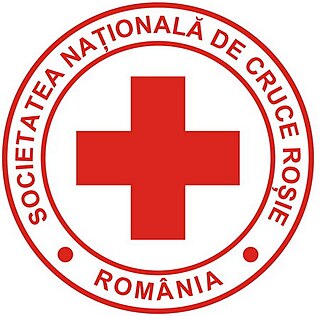
The Romanian Red Cross (CRR), also known as the National Society of Red Cross from Romania, is a volunteer-led, humanitarian organization that provides emergency assistance, disaster relief and education inside Romania. It is the designated national affiliate of the International Federation of Red Cross and Red Crescent Societies.

Helen L. Gilson was born in Chelsea, Massachusetts. She was a nurse during the Civil War. Also known as Helen L. Gilson Osgood.
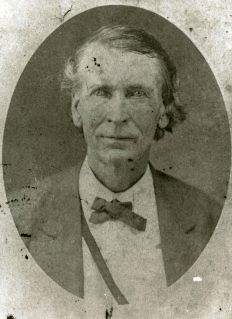
Ira Roe Foster was born along the Tyger River, in Spartanburg County, South Carolina. He was a teacher, medical doctor, attorney, soldier, businessman, and politician. During the 1840s, Foster served as brigadier general in the Georgia Militia.
The history of medicine in the United States encompasses a variety of periods and approaches to health care in the United States from colonial days to the present, ranging from early folk remedies to the increasing professionalization and managed care of modern medicine.

The History of nursing in the United States focuses on the professionalization of nursing since the Civil War.

Emily Elizabeth Parsons was an American Civil War nurse, hospital administrator, and founder of Mount Auburn Hospital in Massachusetts. Her posthumous memoir, Fearless Purpose: Memoir of Emily Elizabeth Parsons, gives a rare glimpse of the American Civil War from a nurse's perspective as she describes her work tending to Union soldiers and managing the nursing staff at Benton Barracks Hospital in St. Louis, Missouri.
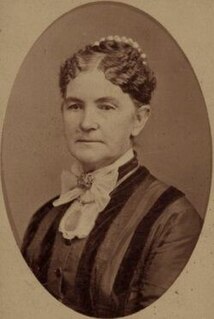
Adaline Weston Couzins was a British-born American civil servant, a suffragist, and a Civil War nurse who worked for the Ladies' Union Aid Society of St. Louis. She spent most of her career as a nurse during the Civil War on hospital ships that tended to Union and Confederate soldiers all along the Mississippi River.
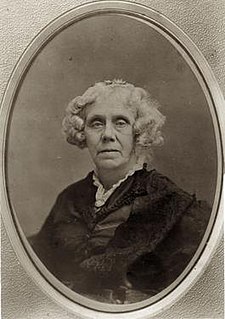
Anna L. Clapp (1814–1889) was the only president of the St. Louis Ladies' Union Aid Society and helped supply for those wounded during the American Civil War. She advocated for women to step outside of their homes and join the efforts to help during the war. She made medical supplies available for injured soldiers and provided shelter for refugees of all color as well. Even when the war was over, she continued to make a difference by creating homes for women and orphans. She was president of the Western Female Guardian Home and the director of the St. Louis Protestant Orphan Asylum.

St. Louis Ladies' Union Aid Society was formed on August 2nd, 1861. During the American Civil War, ladies' aid societies formed across the country to provide medical services and supplies to soldiers. In St. Louis, they partnered with the Western Sanitary Commission in bringing aid to Union soldiers across the state.
Elizabeth "Eliza" George, nicknamed "Mother George" by the Union army soldiers under her care, served the final two-and-a-half years of her life as a volunteer nurse in the South during the American Civil War. Initially discouraged from serving because of her age and the harsh conditions of wartime service, the fifty-four-year-old widow left her Fort Wayne, Indiana, home in February 1863 and died in May 1865 of typhoid fever, which she contracted while nursing soldiers and civilians at Wilmington, North Carolina, a month after the end of the war. George was buried with full military honors at Lindenwood Cemetery in Fort Wayne, Indiana; a monument erected near her gravesite pays tribute to her wartime service.

Elizabeth "Eliza" Harris served as a United States Sanitary Commission agent, army nurse, and newspaper correspondent during the American Civil War. She was active in the Eastern Theater of the American Civil War until September 1863, when she went to Tennessee for several months before returning to the east. After the war, she was active in national reform causes.















